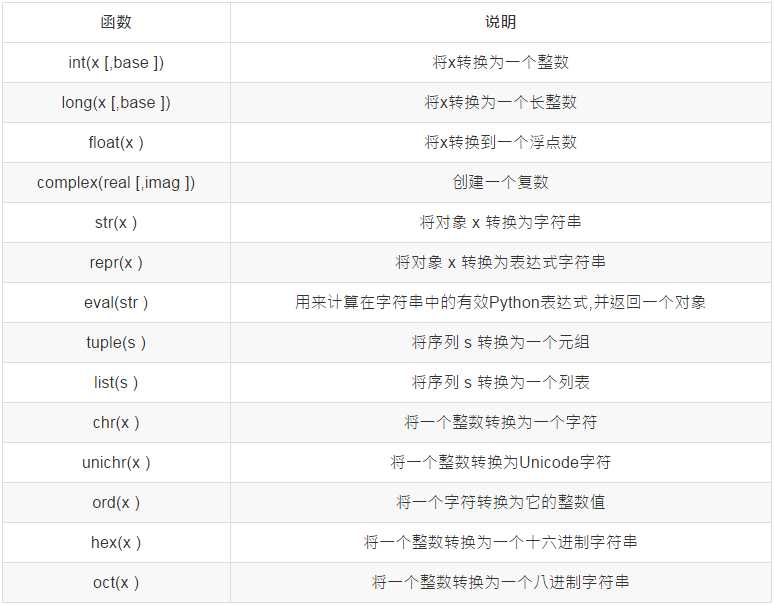标签:数据类型转换 对象 png http 字符串 元素 数据类型 个数 乘法表
1.python优点
简单易学,开元免费,解释性语言,面向对象,功能强大,可扩展性,可移植性
2.变量的类型
数字,布尔类型,字符串,列表,元祖,字典
3.标识符命名规则
1.标识符由字母、下划线和数字组成,且不能以数字开头。
2.Python中的标识符是区分大小写的
3.Python中的标识符不能使用关键字
4.见名知意
5.命名按照大驼峰小驼峰方式命名
4.如何在python中查找关键字
cmd进入终端
输入python
输入import keyword
输入keyword.kwlist
5.常用的格式符号有哪些(3个即可)
%s 通过str() 字符串转换来格式化
%c 字符
%d 有符号十进制整数
%f 浮点实数
6.运算符(至少5个)
+ 加
- 减
* 乘
/ 除
% 取模 - 返回除法的余数
** 幂 - 返回x的y次幂
// 取整除 - 返回商的整数部分(向下取整)
7.python常用的数据类型转换(至少3个

8.计较运算符(至少3个)
== != <= >= < >
9.逻辑运算符是哪3个
and or not
10.自己写一个if-elif-else条件语句并输出
猜拳判断:
print("0石头1剪刀2布")
wan1=int(input("玩家一的回合:"))
wan2=int(input("玩家二的回合:"))
if (wan1>=0 and wan2<=2)and(wan1<=2 and wan2>=0):
if (wan1==0 and wan2==1)or(wan1==1 and wan2==2)or(wan1==2 and wan2==0):
print("玩家一获胜!!")
elif wan1==wan2:
print("平局!!")
else:
print("玩家二获胜!!")
else:
print("参数错误")
11.通过程序写一个等边三角形
while方法:
a = 1
while a <= 6:
print("*" * a)
a += 1
for方法:
for i in range(1,6):
print("*" * i)
12.通过程序写一个九九乘法表
while方法:
a=1
while a<=9:
b=1
while b<=a:
print("%d * %d=%d"%(b,a,b*a),end=" ")
b+=1
print()
a+=1
for方法:
for i in range(1,10):
for b in range(1,i+1):
print("%d * %d =%d"%(b,i,b*i),end=" ")
print()
13.通过代码针对str="abcdefg" :
1取出bcd
2将str倒序
3取出bdf
str=‘abcdefg‘
c = str[1::2]
print(c) #bdf
14.通过代码针对mystr = "hello world python and python"进行如下操作
1.找到右边第一个p的索引
a = mystr.rfind(‘p‘)
2.找z结果要求报错
b = mystr.index(‘z‘)
3.将所有空格替换成逗点
mystr2 = mystr.replace(‘ ‘,‘,‘)
4.通过逗点生成一个列表
mystr2 = mystr.replace(‘ ‘,‘,‘)
alist = mystr2.split(‘,‘)
5.将d全部替换成大写D
mystr2 = ‘‘
for i in mystr:
if i == ‘d‘:
i = i.upper()
print(i)
mystr2 += i
print(mystr2)
15.a = [1,2,3,4,5,6],在a中元素5前添加一个5.5元素
在a中元素6后面添加"我心态炸了"
删除a中的元素1
a = [1,2,3,4,5,6]
a.insert(4,5.5)
a.append(‘我心态炸了‘)
a.remove(1)
16.b = ["a","b","c","b","a"]
查找索引区间在2-4的“b”的索引
查找索引区间在3-4的“a”的索引
b = ["a","b","c","b","a"]
n = b.index(‘b‘,2,4)
n = b.index(‘a‘,3,4)
17.自己写一个字典,计算自己写的字典中存在键值对的个数,找出字典中所有的key,找出字典中所有的value,试着遍历字典中的item,最后删除字典中的第一个键所对应的数据
a = {‘name‘:‘王五‘,‘age‘:18,‘sex‘:‘男‘}
print(a.__len__())
print(a.keys())
print(a.values())
for i in a.items():
print(i)
del a[‘name‘]
print(a)
18.集合中的discard的概念
discard() 方法用于移除指定的集合元素。
该方法不同于 remove() 方法,因为 remove() 方法在移除一个不存在的元素时会发生错误,而 discard() 方法不会。
语法:
set.discard(value)
19.试着自己写两个集合,分别进行 & 和 | 的操作
set1 = {‘李四‘,123,‘a‘}
set2 = {‘张三‘,123,‘b‘}
print(set1&set2)
print(set1|set2)
标签:数据类型转换 对象 png http 字符串 元素 数据类型 个数 乘法表
原文地址:https://www.cnblogs.com/qin-shi-wei/p/13160810.html